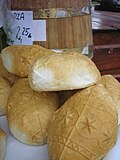Oštiepok

Oštiepok is a traditional Slovak cheese that is well-known for its characteristic smoked flavor and unique shape. This cheese is made from sheep's milk, although cow's milk can also be used as a substitute or in combination. The production of Oštiepok is a highly valued craft within the Slovak culinary tradition, reflecting the country's rich pastoral and agricultural heritage.
Production[edit]
The process of making Oštiepok involves a series of steps that begin with the curdling of sheep's milk. The milk is first heated and then mixed with rennet, a natural enzyme that causes the milk to curdle. The curd is then cut into small pieces to facilitate the release of whey, after which it is heated again and stretched to achieve the desired elastic texture. This stretching process is similar to that used in the production of Italian Mozzarella.
Once the cheese has been shaped, traditionally into forms that resemble small animals or decorative patterns, it is soaked in brine, which adds flavor and acts as a preservative. The final and most distinctive step in the production of Oštiepok is smoking. The cheese is smoked over a wood fire, which imparts the characteristic smoky flavor that sets Oštiepok apart from other cheeses.
Cultural Significance[edit]
Oštiepok is more than just a food item in Slovakia; it is a symbol of the country's cultural and gastronomic heritage. The cheese is often associated with traditional Slovak festivals and celebrations, where it is enjoyed by locals and visitors alike. Its unique taste and appearance make it a popular souvenir for tourists seeking to experience authentic Slovak cuisine.
The art of Oštiepok production is passed down through generations, with each cheese maker adding their personal touch to the process. This has led to a variety of styles and flavors, although all adhere to the basic principles of Oštiepok making.
Geographical Indication[edit]
In recognition of its cultural significance and unique production methods, Oštiepok has been granted Protected Geographical Indication (PGI) status by the European Union. This designation ensures that only cheese produced in specific regions of Slovakia, using traditional methods, can be sold under the name Oštiepok. This protection helps to preserve the cheese's heritage and guarantees its quality and authenticity to consumers.
Culinary Uses[edit]
Oštiepok can be enjoyed in many ways, both fresh and smoked. It is often served sliced as part of a cheese platter, accompanied by fruits, nuts, and wines that complement its rich flavor. The cheese is also a popular ingredient in Slovak cooking, where it is used in a variety of dishes, from simple snacks to elaborate entrees.
See Also[edit]
-
Oštiepok
Ad. Transform your life with W8MD's Budget GLP-1 injections from $75


W8MD offers a medical weight loss program to lose weight in Philadelphia. Our physician-supervised medical weight loss provides:
- Weight loss injections in NYC (generic and brand names):
- Zepbound / Mounjaro, Wegovy / Ozempic, Saxenda
- Most insurances accepted or discounted self-pay rates. We will obtain insurance prior authorizations if needed.
- Generic GLP1 weight loss injections from $75 for the starting dose.
- Also offer prescription weight loss medications including Phentermine, Qsymia, Diethylpropion, Contrave etc.
NYC weight loss doctor appointmentsNYC weight loss doctor appointments
Start your NYC weight loss journey today at our NYC medical weight loss and Philadelphia medical weight loss clinics.
- Call 718-946-5500 to lose weight in NYC or for medical weight loss in Philadelphia 215-676-2334.
- Tags:NYC medical weight loss, Philadelphia lose weight Zepbound NYC, Budget GLP1 weight loss injections, Wegovy Philadelphia, Wegovy NYC, Philadelphia medical weight loss, Brookly weight loss and Wegovy NYC
|
WikiMD's Wellness Encyclopedia |
| Let Food Be Thy Medicine Medicine Thy Food - Hippocrates |
Medical Disclaimer: WikiMD is not a substitute for professional medical advice. The information on WikiMD is provided as an information resource only, may be incorrect, outdated or misleading, and is not to be used or relied on for any diagnostic or treatment purposes. Please consult your health care provider before making any healthcare decisions or for guidance about a specific medical condition. WikiMD expressly disclaims responsibility, and shall have no liability, for any damages, loss, injury, or liability whatsoever suffered as a result of your reliance on the information contained in this site. By visiting this site you agree to the foregoing terms and conditions, which may from time to time be changed or supplemented by WikiMD. If you do not agree to the foregoing terms and conditions, you should not enter or use this site. See full disclaimer.
Credits:Most images are courtesy of Wikimedia commons, and templates, categories Wikipedia, licensed under CC BY SA or similar.
Translate this page: - East Asian
中文,
日本,
한국어,
South Asian
हिन्दी,
தமிழ்,
తెలుగు,
Urdu,
ಕನ್ನಡ,
Southeast Asian
Indonesian,
Vietnamese,
Thai,
မြန်မာဘာသာ,
বাংলা
European
español,
Deutsch,
français,
Greek,
português do Brasil,
polski,
română,
русский,
Nederlands,
norsk,
svenska,
suomi,
Italian
Middle Eastern & African
عربى,
Turkish,
Persian,
Hebrew,
Afrikaans,
isiZulu,
Kiswahili,
Other
Bulgarian,
Hungarian,
Czech,
Swedish,
മലയാളം,
मराठी,
ਪੰਜਾਬੀ,
ગુજરાતી,
Portuguese,
Ukrainian

